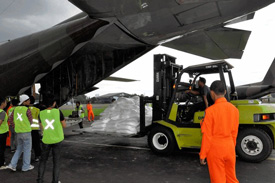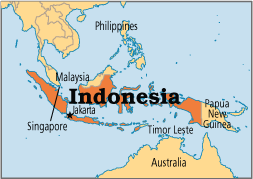redo Jump to...
print Print...

A plane at a Jakarta air-force base with bags of salt to be used in the attempt to reduce rain in the capital.
(by Ben Otto, The Wall Street Journal) ABOVE WEST JAVA, Indonesia – On a recent Sunday, a team of government scientists in a small Navy plane rose to an altitude of 12,000 feet over a corner of Java to meet an enormous cumulus cloud.
“That’s the one that we want,” said one of them, Sunu Tikno, directing the pilots to chart a course into the cloud. As the view went blank, four men in the cargo bay poured dozens of bags of salt, one ton in all, into the sky, their contribution to the world’s first known effort to use cloud seeding to try to prevent flooding.
The sortie, to avert floods in greater Jakarta, home to more than 25 million, was one of several that day that spread nine tons of salt into monsoon skies over Java, part of a 60-day, government-led effort with a price tag of $1.35 million.
In the past, Russia and China have staged attempts to avert rain during high-profile events. Beijing famously fired seeding agents from rockets to try to ensure a rain-free opening ceremony for the 2008 Olympics. But the Indonesian operation appears to be the first to seek to manipulate clouds to release rain before they reach densely populated areas prone to flooding. The effort faces skeptics, including some scientists who say seeding clouds in one area doesn’t necessarily mean it will rain less somewhere else.
…Weather-modification programs may also have business implications. Some of Indonesia’s biggest coal-mining companies – whose open-pit mines are regularly forced to shutter operations when precipitation makes work conditions too slippery – are closely watching the cloud-seeding efforts.
The Jakarta team has so far targeted about a 30% reduction in rainfall by means of a weather-modification technique known as hygroscopic cloud seeding. In theory, ordinary salt should act as a binding agent for water vapor in tropical clouds, helping to amass droplets that will eventually fall as rain. In practice, whether that process can be used to divert rain has been little studied.
William Woodley, a weather-modification researcher who runs a private consulting service in Colorado, calls the 30% goal “absurd,” for an effort with such a shaky scientific basis.
 Indonesia’s move comes after Jakarta, a sprawling megacity at the edge of the Java Sea which has been subject to annual flooding for decades, was hit by its worst floods in years in January, displacing more than 40,000 people and costing businesses more than $1 billion in losses.
Indonesia’s move comes after Jakarta, a sprawling megacity at the edge of the Java Sea which has been subject to annual flooding for decades, was hit by its worst floods in years in January, displacing more than 40,000 people and costing businesses more than $1 billion in losses.
“There has been a big resurgence of interest lately” in weather-modification efforts, says Hugh Willoughby, a professor at Florida International University. In the early 1980s, Mr. Willoughby was among the scientists to pull the plug on Project Stormfury, a two-decade U.S. study that concluded that cloud seeding probably couldn’t be used to weaken hurricanes. He says new science, models and methods of looking into clouds have convinced many to revisit the field.
“It’s not a crazy idea,” he says of Jakarta’s program. “What the Indonesians want to do could work.”
Major projects under the quasiscience of weather modification in the U.S. date back more than 50 years. But cloud seeding has historically been employed to bring more rain to settled areas – not drive it away.
In the U.S. and Canada, private investors have spent heavily over the years to attract rain or snow to farms, river basins and ski resorts. China’s weather-modification program, the world’s largest, employs tens of thousands of people to stave off drought and help crops.
Rain-diversion efforts are much less common. Russia seeds skies over Moscow several times a year during national events; it also tried to seed wintertimeclouds to reduce snowfall for a spell in the 1980s. Both Russia and China say their efforts have been successful, but several leading scientists have dismissed any success as coincidence.
…Joe Golden, a weather-modification expert who once chaired the now-defunct Atmospheric Modification Program at the National Oceanic and Atmospheric Administration (NOAA), calls the Indonesian effort “a very risky enterprise, at best,” noting that some evidence suggests that cloud seeding can produce more, not less, rain.
Nevertheless, Indonesia’s disaster-mitigation agency that is funding the program believes its effort is working. This week, it declared victory in Jakarta and moved the program to Central Java, where it hopes to curb dangerous mudflows on one of the world’s most active volcanoes, Merapi, and to reduce flood risk in a wider region home to tens of millions of people. It already says it wants to expand the operation to other areas of Java next year.
“It’s like going to a doctor for the flu,” says Tri Handoko Seto, the meteorologist leading the effort. “You get the medicine and three days later you feel better. But was it really the medicine that made the difference? You can’t say for certain.”
He has at least another month to convince skeptics that what he is doing is working. But importantly for the future of the program, he has the backing of Jakarta’s new governor, Joko Widodo, a forestry graduate who says he wants the program to continue next year.
“The city’s been flooding for 40 years,” Mr. Widodo said. “We need to try everything.”
Copyright 2013 Dow Jones & Company, Inc. All Rights Reserved. Reprinted here for educational purposes only. Visit the website at wsj.com.
Questions
1. a) What is the capital of Indonesia?
b) What is the population?
c) Who is the president of Indonesia?
d) What is the religious breakdown of this country?
e) Where is it located?
2. a) What are government scientists attempting to do in Indonesia?
b) What recent event triggered this effort?
3. a) How has cloud seeding historically been used?
b) What countries, and for what reasons, have attempted to prevent rain using cloud seeding?
4. What specific industry could be helped if scientists are successful at their weather modification attempt in Indonesia?
5. a) What is the goal for the Jakarta team’s weather modification efforts?
b) What procedure are they using to make this happen?
6. How do various experts, as well as Jakarta’s new governor, view the program?
Background
WEATHER MODIFICATION:
Weather modification is the act of intentionally manipulating or altering the weather. The most common form of weather modification is cloud seeding to increase rain or snow, usually for the purpose of increasing the local water supply. Weather modification can also have the goal of preventing damaging weather, such as hail or hurricanes, from occurring; or of provoking damaging weather against an enemy or rival, as a tactic of military or economic warfare. Weather modification in warfare has been banned by the United Nations. (from wikipedia)
ON THE PRACTICE OF CLOUD-SEEDING:
Cloud seeding is a common technique to enhance precipitation. Evidence on its safety is strong, but there are still doubts about its effectiveness. Cloud seeding entails spraying small particles, such as aluminium oxide, barium, (like silver iodide) onto clouds in order to affect their development, usually with the goal of increasing precipitation. Cloud seeding only works to the extent that there is already water vapor present in the air. (from wikipedia)
- The United States began weather control research in 1946. Currently, some states use cloud-seeding programs in an attempt to increase precipitation levels or prevent crop-damaging hail. An eight-year experiment in Texas and Oklahoma, conducted over 5,000 square miles, showed that cloud seeding increased rainfall, cloud height, length of storms and the area in which rain fell. Even so, enthusiasm for cloud seeding in the U.S. has dried up since the early 1970s, when federal funding was about $19 million a year.
- Internationally, Russia, Israel, Thailand, South Africa and Caribbean nations have all tried their hand at cloud seeding, with mixed results. Australian scientists conducted numerous experiments, discovering that static seeding didn’t appear to be effective over Australia’s plains but was very effective over Tasmania.
- Despite some successful tests, cloud seeding still has many problems. The fundamental concern is:
Does it work? It may be a chicken-and-egg conundrum — would it have rained in a given area without the use of cloud seeding, and would it have rained less? Cloud seeding also depends heavily on environmental conditions like temperature and cloud composition. - In 2003, the United States National Academy of Sciences declared that 30 years of studies had not produced “convincing” evidence that weather modification works. On the other hand, the American Meteorological Society claims that some studies on cloud seeding show a 10 percent increase in rain volume.
- Despite reassurances from cloud-seeding companies, concerns also remain about exposure to silver iodide toxicity and soil contamination. …cloud seeding has strong supporters, but it remains controversial.
- Scientists may not be sure if cloud seeding actually works, but despite the skepticism, China is moving forward. The nation spends $60 to $90 million a year on weather modification, in addition to the $266 million spent from 1995 to 2003. … (from science.howstuffworks.com/cloud-seeding2.htm)
Resources
For information about Utah’s cloud seeding program, visit the Utah state government site at water.utah.gov/cloudseeding.
Daily “Answers” emails are provided for Daily News Articles, Tuesday’s World Events and Friday’s News Quiz.



